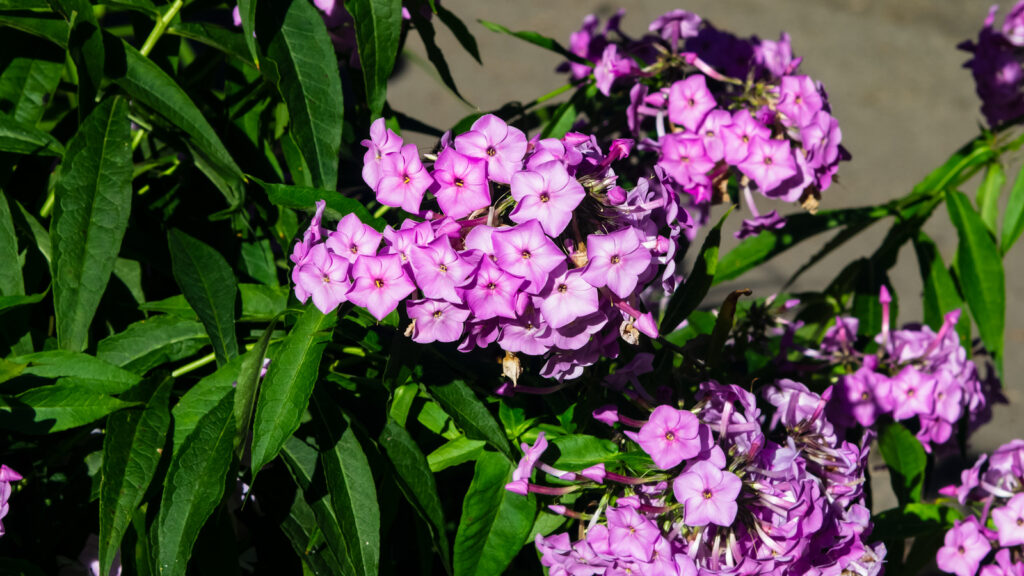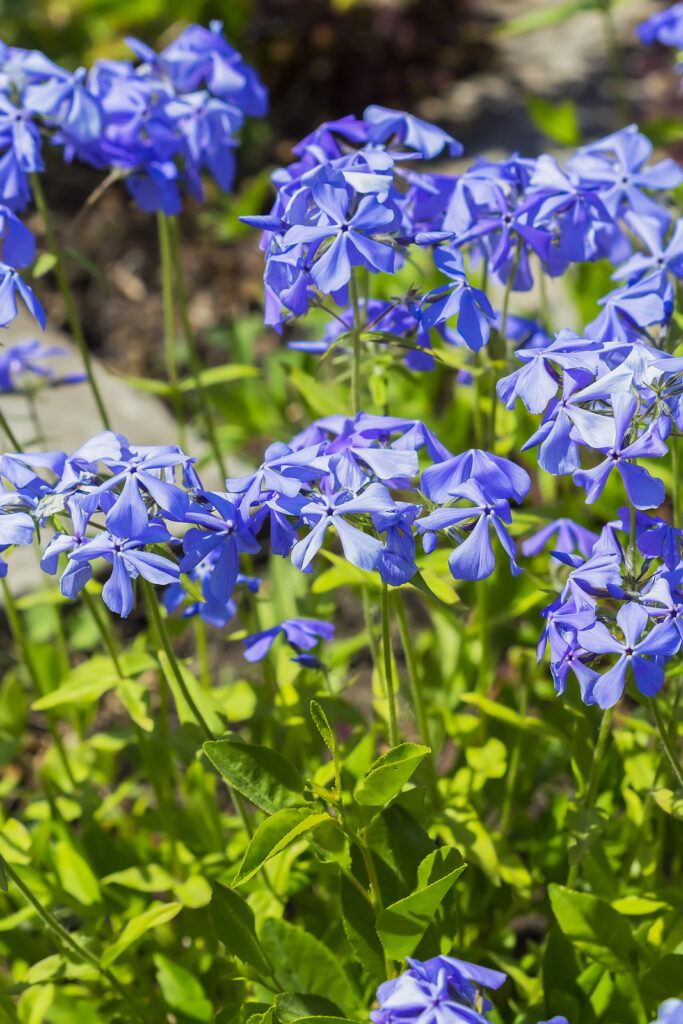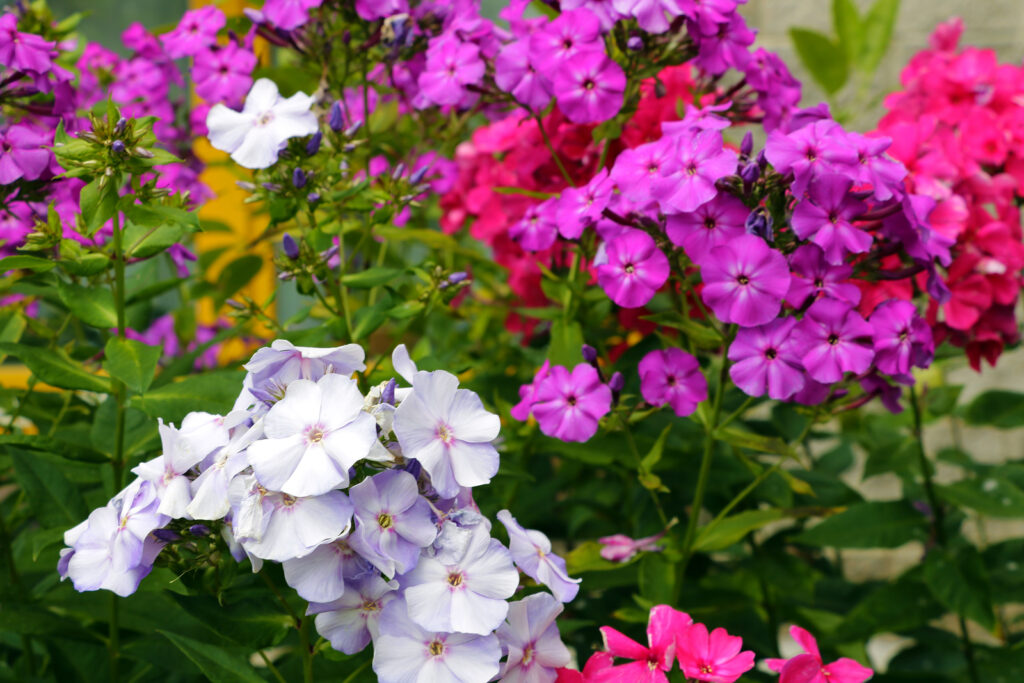There are many types of phlox. All are known for their showy flower clusters. There are tall-growing phlox that can be used as border plants and there are dwarf-growing varieties that can be used in rock gardens and as edging plants along paths. Most phlox species are perennials; the annual species Phlox drummondii is perhaps the most widely grown.
Annual phlox–botanical name Phlox drummondii— is a bushy annual with neat green leaves and clusters of small pink, red, purple, blue, and white flowers that appear throughout the summer. Leaves are lance-shaped and narrow.
Annual Phlox is a Texas native. Seeds can be sown outdoors after all danger of frost is past. In mild winter and desert regions, seeds can be planted in the fall.
Annual phlox is a good choice for bedding. It can serve as a ground cover for summer-blooming bulbs.
Other phlox species commonly grown in gardens include sand phlox (P. bifida) which grows to 10 inches tall and 2 feet wide; wild blue phlox (P. divaricata) which grows to 12 inches tall and 2 feet wide; thick-leaf phlox (P. maculata) which grows 3 to 4 feet tall and 18 inches wide; summer phlox (P. paniculata) which grows 3 to 5 feet tall and 2 feet wide; creeping phlox (P. stolonifera) which grows 6 to 8 inches tall and 12 inches wide; and moss pink phlox (P. subulata) which grow 6 inches tall and 18 inches wide. See below for more on some of these.
Get to know annual phlox — Phlox drummondii
- Plant type: Annual
- Growing Zones and range: Zones 4-9
- Hardiness: Tender
- Height and width: 6 to 20 inches (15-50cm) tall; up to 10 inches (25cm) or more wide
- Foliage: Narrow, inversely lance-shaped to nearly ovate leaves 1-3 inches long
- Flowers: Tight clusters of star-shaped flowers 1 inch across
- Flower colors: Shades of pink, red, salmon, purple, mauve, and white; many flowers are bicolored
- Bloom time: Summer to frost
- Uses: Bedding, edging, rock gardens, containers
- Common name: Annual phlox, Drummond phlox
- Botanical name: Phlox drummondii
- Family: Polemoniaceae
- Origin: Noth America
Where to plant annual phlox — Phlox drummondii
- Plant annual phlox in full sun.
- Grow annual phlox in humus-rich, well-drained soil.

When to plant annual phlox — Phlox drummondii
- Sow annual phlox seeds directly in the garden in early spring in Zones 2-6. In Zones 7-11 sow seeds in late autumn for winter or early spring bloom.
Planting and spacing annual phlox — Phlox drummondii
- Space annual phlox 6 to 8 inches apart. Plant annual phlox in groups of a dozen plants or more for best effect.
How to water and feed annual phlox — Phlox drummondii
- Annual phlox needs moderate moisture; keep the soil evenly moist.
- Fertilize annual phlox with an all-purpose fertilizer every 4 to 6 weeks.
Annual phlox care — Phlox drummondii
- Remove spent blooms to encourage new flowers.
- Heat will slow or stop annual phlox; the plant will revive in the fall.
Annual phlox varieties to grow
- ‘Dwarf Beauty’ grow to 6 inches tall.
- ‘Brilliant’ grows to 2 feet tall.
- Globe Mixed are dwarf mounding cultivars.
Annual phlox frequently asked questions
Q: When do I plant annual phlox in the garden?
A: Annual phlox is slightly resistant to frost. You can sow seeds indoors 8 to 10 weeks before the last frost. Set young plants into the garden a few weeks before the last frost as long as the soil is workable. Place phlox where it can grow in full sun.
Q: How do I start phlox from seed?
A: Sow seeds indoors 8 to 10 weeks before the outdoor planting date. Sow seeds in individual pots; seedlings do not like transplanting. Start seeds in a cool room; this is important for germination. Cover the seeds completely; they need darkness to germinate. Be careful not to overwater; young plants are susceptible to damping off.
Q: What care do phlox need in the garden?
A: Fertilize phlox monthly with soluble plant food. Keep phlox well-watered. Remove faded flowers. Cut leggy plants back to encourage compactness. Phlox is fairly heat-resistant but may decline in mid-summer heat.

How to grow woodland phlox – Phlox divaricata
Woodland phlox bear small star-shaped lavender-blue blooms from mid-to-late spring. Woodland phlox is a creeping semi-evergreen perennial bears narrow, lance-shaped mid-green leaves on purplish upright stems.
Get to know woodland phlox – Phlox divaricata
- Plant type: Perennial
- Growing Zones and range: 3-9
- Hardiness: Tender
- Height and width: 12”- 18” tall; 1’- 2’ wide
- Flowers: Pale blue, pink, white
- Bloom time: Mid to late spring
- Uses: Shade garden, woodland garden
- Botanical name: Phlox divaricata
- Common name: Woodland phlox, wild blue phlox
Where to plant woodland phlox – Phlox divaricata
- Grow woodland phlox in light or dappled shade.
- Plant woodland phlox in humus-rich, well-drained soil that is moisture retentive.
When to plant woodland phlox – Phlox divaricata
- Set woodland phlox in the garden inspiring.
Planting and spacing woodland phlox – Phlox divaricata
- Space woodland phlox 12 to 18 inches apart.
- Work aged compost into the soil before planting.
How to water and feed woodland phlox – Phlox divaricata
- Woodland phlox grow best in evenly moist soil; do not let the soil dry out.
- Feed woodland phlox by adding aged compost to the soil and by mulching with aged compost.
Woodland phlox – Phlox divaricata care
- Mulch around woodland phlox with aged compost.
- Cut woodland phlox back after flowering to promote more blooms and compact growth.
- Divide plants after blooming or in the fall.
- Woodland phlox may be attacked by slugs,
- Woodland phlox is susceptible to mildew.
Woodland phlox – Phlox divaricata varieties to grow
- ‘Dirogo Ice’ bears clear, pale blue flowers.
- ‘Fuller’s White’ is compact and white-flowered.
Phlox maculata — Wild sweet William, spotted phlox
Phlox maculata looks very similar to garden phlox, however, flower cluster are more conical in shape and flowers bloom earlier that garden phlox. Spotted phlox flowers are lightly fragrant. Flower are about 1 ½ -inch across; they appear in tightly clusters atop the tall stems in early summer and again later in the year if cut back. The species is light magenta-pink; cultivars include snow-white and purer pinks. The upright, hairy stems are usually mottled red. The dark green leaves are mildew resistant. Phlox maculata grow 2 to 3 feet tall; 2 feet wide. Mass this plant in garden borders for best display.
Where to plant Phlox maculata
- Grows best in Zones 3-9.
- Plant in full sun to light shade.
- Plant in fertile, humus-rich, moist, well-drained soil.
When to plant Phlox maculata
- Plant bare-root or container-grown plants in spring, spacing 2 ½ feet apart.
- Divide every three or four years in spring.
Special care: Cut back after blossoms fade to encourage rebloom.
Phlox maculata pests and diseases
- Phlox maculata is more resistant to mildew than garden phlox but affected some.
- Provide good air circulation; avoid overhead watering.
Phlox maculata cultivars
- ‘Miss Lingard,’ snow-white, sometimes listed as P. carolina; ‘Omega,’ white with lilac eye; ‘Alpha,’ rose-pink with dark eye; ‘Rosaline,’ dark pink.

How to grow summer garden phlox – Phlox paniculata
Garden phlox–botanical name Phlox paniculata— bears fragrant, five-petaled flowers in clusters from early summer to mid-autumn. The fragrant flowers are white or pale to dark lilac. Garden phlox is an herbaceous perennial with lance-shaped toothed, thin leaves, a good choice for mass plantings and borders.
Get to know summer garden phlox – Phlox paniculata
- Plant type: Perennial
- Growing Zones and range: 4-8
- Hardiness: Hardy to -35° (-37°C)
- Height and width: 24 inches to 4 feet (1.2m) tall; 24 to 39 inches (60-100cm) wide
- Foliage: Ovate or lance-shaped to elliptic, toothed, thin leaves 2 to 5 inches (1.5-2.5cm) long
- Flowers: Salverform (a narrow tube with petals bent abruptly outward at right angles) blossoms on panicle-like cymes
- Flower colors: Wild forms are magenta; hybrids are shades of pink, red, lilac, or white and some are bicolored
- Bloom time: Early, mid-, or late summer depending on the variety
- Uses: Mass plantings, borders
- Common name: Garden phlox, summer phlox
- Botanical name: Phlox paniculata
- Family: Polemoniaceae
- Origin: North America
Where to plant summer garden phlox – Phlox paniculata
- Plant garden phlox in full sun in Zones 3-6; plant in light shade in hot-summer regions in Zones 7-9.
- Grow phlox in compost-rich, well-drained soil.
When to plant summer garden phlox – Phlox paniculata
- Set garden phlox in the garden in spring or fall.
Planting and spacing summer garden phlox – Phlox paniculata
- Space garden phlox 18 to 24 inches apart. Space plants so that they are not crowded; crowded plants are susceptible to mildew.
How to water and feed summer garden phlox – Phlox paniculata
- Garden phlox wants ample moisture; do not let the soil dry out.
- Fertilize garden phlox with an all-purpose, slow-release fertilizer each spring.
Summer garden phlox – Phlox paniculata care
- Mulch around garden phlox to conserve soil moisture.
- Cut garden phlox back by one-third after blooming to encourage new blooms.
- Cut back garden phlox that is attacked by mildew.
Summer garden phlox – Phlox paniculata propagation
- Phlox paniculata seeds will germinate in 5-10 days at 60-65°F (16-18°C).
Summer garden phlox – Phlox paniculata varieties to grow
- There are numerous cultivars of Phlox paniculata.
- Mildew-resistant cultivars include ‘Miss Lingard’, ‘Mt. Fuji’, ‘David’, ‘Franz Schubert, and ‘Eva Cullum’.
- Phlox maculata, also called wild sweet William or spotted phlox is more mildew resistant than Phlox paniculata.

How to grow creeping phlox – Phlox stolonifera
Creeping phlox–botanical name Phlox stolonifera– is a low-spreading perennial that bears a profusion of pale to deep purple starry flowers. Creeping phlox is a perennial with obovate, dark green leaves two inches long.
Creeping phlox generally remains under 12 inches tall. Creeping phlox has slightly larger flowers than other phlox.
Get to know creeping phlox – Phlox stolonifera
- Plant type: Perennial
- Growing Zones and range: 2-8
- Hardiness: Hardy to -35°F (-37°C)
- Height and width: 6 to 12 inches tall; 8 to 12 inches wide
- Foliage: Obovate, dark green leaves to 2 inches (5cm) long
- Flowers: Salverform flowers on upright stems; flowers appear in small clusters
- Flower colors: Pale to deep purple, pink
- Bloom time: Summer
- Uses: Groundcover, shade gardens, woodland gardens
- Common name: Creeping Phlox
- Botanical name: Phlox stolonifera
- Family: Polemoniaceae
- Origin: Woodlands in Central America
Where to plant creeping phlox – Phlox stolonifera
- Plant creeping phlox in light shade in Zones 2-6; plant in full or dappled shade in Zones 7-8. Plants in cool summer regions can tolerate the sun.
- Creeping phlox need humus-rich, well-drained soil that is moisture retentive.
Creeping phlox – Phlox stolonifera uses and companions
- Use Phlox stolonifera as a ground cover.
- Grow Phlox stolonifera in a shade or woodland garden.
When to plant creeping phlox – Phlox stolonifera
- Set creeping phlox in the garden in spring.
- Add aged compost to the soil at planting time.
Planting and spacing creeping phlox – Phlox stolonifera
- Space creeping phlox 8 to 12 inches apart.
How to water and feed creeping phlox – Phlox stolonifera
- Creeping phlox need to be kept well-watered. Do not let the soil dry out.
- Fertilize creeping phlox with aged compost.
Creeping phlox – Phlox stolonifera care
- Mulch around creeping phlox to conserve soil moisture. Be careful that mulch does not cover leaves.
- Creeping phlox will reseed if you let the flowers go to seed.
- Creeping phlox also spreads by underground runners.
- Mildew and slug can attack creeping phlox.
Creeping phlox – Phlox stolonifera propagation
- Phlox stolonifera seeds will germinate in 5 to 10 days at 608° to 65°F (16°-18°C).
Creeping phlox – Phlox stolonifera varieties to grow
There are several Phlox subulata cultivars:
- ‘Ariane’ and ‘Bruce’s White’ has white flowers.
- ‘Blue Ridge’ has sky blue flowers and grows to 12 inches tall.
- ‘Home Fires’ and ‘Pink Ridge’ has deep pink flowers.
- ‘Sherwood Purple’ bears purple-blue fragrant flowers.

How to grow moss phlox – Phlox subulata
Moss phlox or creeping phlox–botanical name Phlox subulata–is a dense evergreen perennial that forms cushions of bright green leaves. Starry purple or red, sometimes violet-purple, lilac, pink, or white flowers appear in groups in late spring and early summer.
Moss Phlox–Phlox subulata–can be used as a small-scale ground cover or foreground plant in beds and borders. Moss phlox flowers for a month starting in late spring. The plant is smothered in small blossoms, lavender-blue, white, and shades of pink and violet.
Get to know moss phlox – Phlox subulata
- Plant type: Evergreen perennial
- Growing Zones and range: 2-9
- Hardiness: Hardy to -30ºF (-34ºC); moss phlox does not like heat or drought.
- Height and width: 2 to 6 inches (5-15cm) tall; to 20 inches (50cm) wide
- Habit: Lax, forming cushions or mats
- Foliage: Hairy, linear to elliptic, bright green leaves to 3/4 inch long
- Flowers: Star-shaped petal lobes; white, pink, or lavender blooms
- Bloom time: Spring blooms followed by lush green foliage
- Uses: Matlike groundcover, hillsides
- Common name: Moss Phlox, creeping phlox
- Botanical name: Phlox subulata
- Family: Polemoniaceae
- Origin: North America
Where to plant moss phlox – Phlox subulata
- Plant moss phlox in full sun.
- Grow moss phlox in average or poor, rocky soil that is dry. Moss phlox prefers alkaline soil.
Moss phlox uses and companions – Phlox subulata
- Use Phlox subulata as a ground cover or bedding in informal beds and borders.
- Plant Phlox subulata in a rock garden.
- Good companions for moss phlox include Aster, Chrysanthemum, Monarda, Physostegia viginiana, Platycodon grandiflorus.
When to plant moss phlox – Phlox subulata
- Set established moss phlox in the garden in spring. Divide plants in the fall.
- Planting and spacing moss phlox
- Space moss phlox 18 to 24 inches apart.
How to water and feed moss phlox – Phlox subulata
- Moss phlox grows in soil that is just moist, not wet; water moss phlox occasionally after it is established. Moss phlox does not like heat or drought.
- Moss phlox does not require fertilizing.
Moss phlox – Phlox subulata care
- Cut moss phlox back to encourage dense growth and continued flowering.
- Moss phlox is susceptible to spider mites in hot, dry conditions. It is susceptible to root rot in wet winter conditions.
Moss phlox – Phlox subulata propagation
- Phlox subulata seeds will germinate in 5 to 10 days at 60-65°F (16-18°C)
Moss phlox – Phlox subulata varieties to grow
- Phlox nana grows well in the arid Southwest.
- ‘Amazing Grace’ bears pale pink flowers with pinkish-purple eyes.
- ‘Apple Blossom’ bears pale lilac flowers.
- ‘Candy Stripe’ has bicolored flowers of white and pink.
- ‘Emerald Blue’ has light blue flowers.
- ‘May Snow’ and ‘White Delight’ has white flowers.
- ‘Red Wings’ has crimson flowers.















